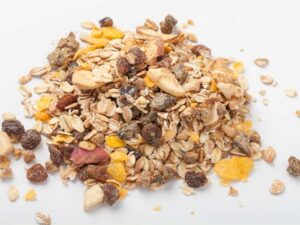Nuts pack a surprising punch as it relates to potassium, a mineral that keeps muscles working smoothly and blood pressure in check. While bananas often steal the spotlight, pistachios, almonds, and sunflower seeds quietly deliver just as much—if not more—of this essential nutrient per serving. But how much potassium do different nuts actually contain, and what’s the ideal way to include them in meals without overdoing it? The responses could change how people snack for good.
Understanding Potassium and Its Importance in the Diet
Why is potassium such a big deal for the body? Potassium keeps nerves firing, muscles moving, and the heart beating steadily. It balances fluids, helps cells communicate, and keeps blood pressure in check. Without enough of this mineral, cramps, fatigue, or even irregular heartbeats can creep in.
High potassium intake supports these crucial functions, but balance is key—too much or too little disrupts the body’s harmony. Adults need about 4,700 mg daily, though needs vary by age and health. For those with kidney issues, monitoring high-potassium foods is pivotal.
While nuts pack a potassium punch, cooking methods like soaking can adjust levels. Comprehending potassium’s role makes it easier to fuel the body right—without overdoing it.
Top Nuts With High Potassium Content
Though nuts are often praised for their healthy fats and protein, many also deliver a solid dose of potassium, a mineral that keeps the body running smoothly.
For those seeking high potassium nuts, certain varieties stand out.
- Pistachios: With 285 mg per ounce, these green gems pack a potassium punch.
- Almonds: Offering 202 mg per ounce, they’re a crunchy, high potassium choice.
- Sunflower seeds: Though technically a seed, they lead with 360 mg per ounce.
These potassium nuts support muscle function and heart health, making them smart snacks.
While Brazil nuts and walnuts have less, pistachios, almonds, and sunflower seeds shine for those needing more potassium. Choosing these can help meet daily needs without extra effort.
Serving Sizes and Potassium Levels in Various Nuts
Grasping serving sizes helps make the most of nuts’ potassium benefits without overdoing it. A standard 1-ounce serving—about a handful—provides varying potassium per nut type. Pistachios lead with 285 mg, while almonds offer 202 mg, peanuts 180 mg, cashews 160 mg, and walnuts 125 mg.
Keeping portions consistent comprehends balanced intake without excess calories. For those tracking potassium, pistachios deliver the most per serving, but almonds and peanuts are solid choices too. Cashews and walnuts, though lower, still contribute meaningfully.
Measuring servings prevents unintentional overconsumption, especially for those monitoring nutrients. Since nuts are calorie-dense, sticking to recommended sizes maximizes their health perks. Recognizing these differences helps tailor intake to personal dietary needs while enjoying their natural benefits.
Comparing Almonds and Other Nuts for Potassium
Almonds pack a solid 202 mg of potassium per ounce, putting them ahead of many popular nuts but still trailing behind pistachios. While almonds contain a respectable amount of this essential mineral, their potassium content varies compared to other nuts.
Pistachios lead with 285 mg per ounce, making them the top choice for those seeking nuts high in potassium.
Peanuts and Brazil nuts fall slightly behind, offering 180 mg and 187 mg respectively, while walnuts provide just 125 mg.
Almonds rank mid-tier, balancing good potassium levels with other nutritional comprehension.
For anyone focusing on potassium intake, recognizing these differences helps in making informed snack choices. Though almonds contain a healthy dose, pistachios deliver even more, while walnuts lag behind. The key is picking nuts that align with dietary needs.
Benefits of Potassium-Rich Nuts for Health
Potassium-rich nuts support heart health by helping maintain stable blood pressure levels. They also aid muscle function by preventing cramps and weakness, especially after exercise.
Regular consumption of these nuts can be an effective way to manage potassium intake while benefiting overall wellness.
Heart Health Support
- Reduced inflammation: The combination of potassium and healthy fats in nuts can help lower inflammation, a key factor in heart disease.
- Cholesterol control: Regular consumption of potassium-dense nuts can assist in managing cholesterol levels, reducing artery-clogging LDL.
- Balanced electrolytes: Nuts like Brazil nuts and pumpkin seeds replenish potassium lost through sweat, aiding heart rhythm stability.
Including a variety of these nuts in meals not only boosts heart health but also provides fiber and protein, promoting long-term wellness without unnecessary calorie concerns.
Muscle Function Enhancement
As muscles cramp or feel weak during exercise, it’s often a sign that the body needs more potassium—a mineral that helps nerves and muscles communicate smoothly. Nuts like almonds and pistachios, packed with potassium, help prevent these issues by ensuring efficient muscle contractions.
Without enough, cramps, weakness, or even paralysis can occur. However, excess potassium can disrupt heart rhythms, so balance is key. Those with kidney concerns should monitor intake, as impaired kidneys struggle to filter potassium.
Preparing nuts by soaking and draining reduces their potassium content, offering safer selections. Daily needs range from 0.4 grams for infants to 4.7 grams for adults. Including potassium-rich nuts in meals supports muscle function without overloading the body.
Blood Pressure Regulation
Maintaining healthy blood pressure starts with simple choices, like reaching for a handful of nuts. Potassium-rich nuts, such as almonds or pistachios, help balance sodium levels, easing strain on blood vessels. This mineral encourages the kidneys to flush excess sodium, supporting smoother blood pressure regulation.
Sodium Balance: Potassium counters sodium’s effects, reducing water retention and artery pressure.
Kidney Support: Efficient sodium removal prevents fluid buildup, lessening heart workload.
Portion Awareness: Overeating potassium-heavy nuts risks heart rhythm issues—stick to small servings.
While nuts like hazelnuts offer benefits, those with kidney concerns should monitor intake. The right amount—around a handful daily—can aid blood pressure without overloading the body. Moderation guarantees potassium works for health, not against it.
Potassium in Nut Butters: What to Know
Ever pondered how much potassium your favorite nut butter packs? Peanut butter, whether creamy or chunky, offers 208–238 mg per 2-tablespoon serving, while almond butter provides slightly more at 240 mg. Cashew butter trails with 164 mg, but hazelnut butter leads at 280 mg.
Nut butters aren’t just tasty—they’re potassium-rich options for heart health and muscle function. The variation depends on the nut type and processing. Natural versions often retain more nutrients than heavily processed ones.
For those watching sodium intake, unsweetened varieties are smarter picks. Spread it on toast, blend into smoothies, or eat it straight—nut butters make potassium easy to enjoy. Just check labels, as added sugars or salts can offset benefits.
How to Incorporate High-Potassium Nuts Into Your Meals
Many people overlook the simple ways to include high-potassium nuts into daily meals, yet these small changes can make a big difference in overall health. Incorporating nuts and seeds like almonds, pistachios, or macadamia nuts can be effortless and flavorful.
Salads & Yogurt: Sprinkle chopped walnuts or pumpkin seeds over salads or yogurt for crunch and extra potassium.
Stir-Fries & Grains: Toss crushed cashews or hazelnuts into stir-fries or cooked grains for added texture.
Smoothies & Snacks: Blend almond butter into smoothies or mix macadamia nuts into trail mix for a nutrient-packed bite.
These small tweaks embed meals stay balanced while boosting potassium intake naturally. For those seeking variety, experimenting with different nuts and seeds keeps flavors fresh and nutrition diverse.
Raw vs. Roasted: Does Preparation Affect Potassium Levels?
Some nuts lose a small amount of potassium at the time roasted, but the difference isn’t drastic. Roasting reduces potassium levels by 5-15%, but raw and roasted nuts still remain solid choices for a high-potassium food list. Those tracking potassium for medical advice should note the slight drop, though it rarely impacts dietary goals considerably. Below is a comparison of raw vs. roasted nuts:
| Nut Type | Raw (mg/oz) | Roasted (mg/oz) |
|---|---|---|
| Almonds | 208 | 182 |
| Cashews | 160 | 154 |
| Peanuts | 180 | 160 |
| Walnuts | 125 | 120 |
The table shows minor changes, so personal preference—flavor or texture—often matters more than potassium content.
Potential Health Considerations for Consuming High-Potassium Nuts
Individuals with kidney disease often need to monitor their potassium intake carefully, as high-potassium nuts can worsen their condition.
Some medications, like certain blood pressure drugs, can interact with potassium levels, making nut consumption a potential concern. Choosing lower-potassium options or adjusting portion sizes could help manage these risks effectively.
Kidney Disease Restrictions
Managing potassium intake becomes essential for those with kidney disease, especially when including nuts in their diet. While nuts provide heart-healthy monounsaturated and polyunsaturated fats, their potassium and oxalate content can pose risks for compromised kidneys. Careful selection and portion control are key.
High-potassium nuts like almonds, pistachios, and cashews might need strict limitation, as excess potassium can strain kidney function.
Lower-potassium options such as walnuts, pecans, or macadamias offer a safer choice for protein and healthy fats without overloading potassium.
Oxalate awareness is also crucial—nuts like almonds and cashews contain oxalates, which some with kidney disease need to restrict to avoid complications.
Consulting a renal dietitian helps tailor nut intake to individual needs, balancing nutrition and safety. Small adjustments guarantee nuts remain a manageable part of the diet.
Medication Interactions Risk
Beyond dietary restrictions for kidney health, the potassium content in nuts can also affect those taking certain medications. People on potassium-sparing diuretics or ACE inhibitors should watch their intake of high-potassium nuts like almonds, pistachios, or cashews, as these can raise potassium levels dangerously.
Mixed nuts, while convenient, could contain varying amounts of potassium depending on the type of nut included. Those with heart conditions, like arrhythmias, should also be cautious, as excess potassium can worsen symptoms.
Even gastrointestinal issues, such as Crohn’s disease, might increase hyperkalemia risk. For those with kidney stones, high-oxalate nuts like almonds or hazelnuts may need limiting. Always check with a doctor to balance nut consumption with medication needs safely.
Other Nutrients in Nuts Beyond Potassium
Nuts pack more than just potassium—they’re loaded with a variety of nutrients that support overall health. Beyond their mineral content, nuts provide essential fatty acids, monounsaturated fats, and other key compounds that benefit the body.
Healthy Fats: Many nuts, like almonds and cashews, are rich in monounsaturated fats and omega-3 fatty acids, which sustain heart and brain function.
Magnesium & Fiber: A handful of nuts delivers magnesium for muscle and bone health, plus fiber to aid digestion and keep you full.
Antioxidants & Phytosterols: These compounds fight inflammation and can help lower cholesterol, reducing the risk of heart disease.
Nuts also offer plant-based protein, making them a smart snack for energy and muscle repair. Their nutrient density makes them a powerhouse for long-term wellness.
Conclusion
Nuts nourish the body with potassium; they support heart health, muscle function, and nerve signaling. Pistachios lead with robust levels; almonds and walnuts follow closely. Sunflower seeds surprise with their richness; Brazil nuts add variety. Whether raw or roasted, these snacks deliver benefits. Enjoy them mindfully—balance is key. Potassium-packed nuts fit seamlessly into meals, offering both flavor and purpose. A handful makes a difference; a habit builds vigor.


